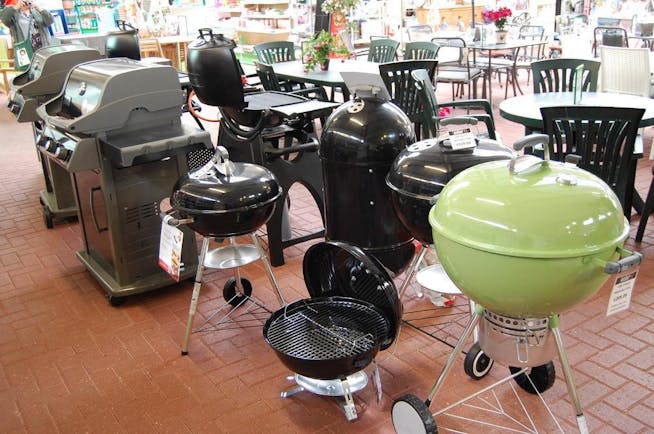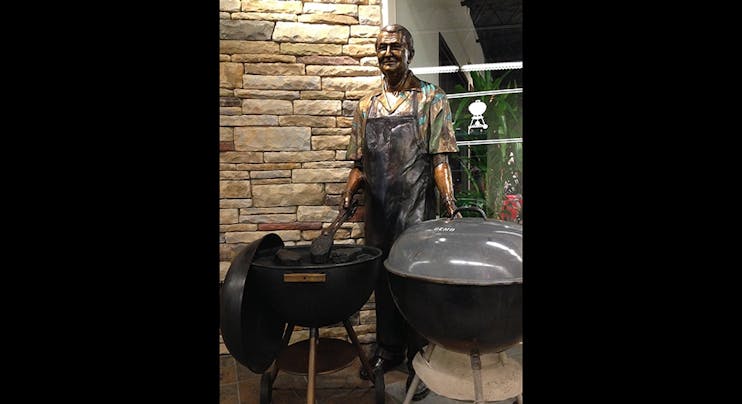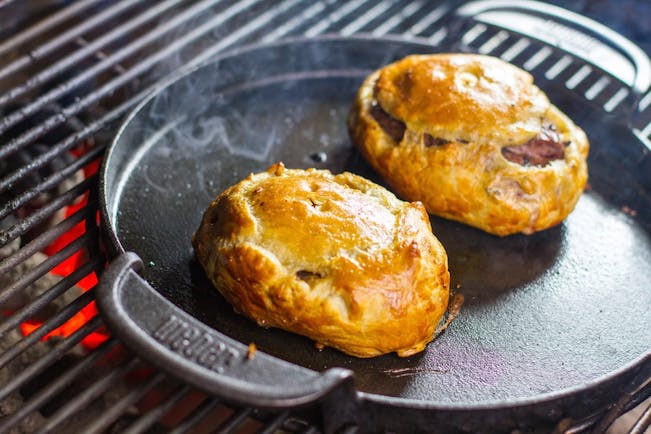Firing Up The Firefighters
Firefighters work long shifts, and they bunk overnight and take their meals in the firehouse. That way, they are always ready to go when an alarm sounds. It’s common for one or two firefighters to become the designated cooks, and their job is to keep the troops fed. Many of these cooks are appointed by default, and because they are often without an ounce of culinary training, firehouse food can be less than satisfying. The confluence of these circumstances sparked (pardon the pun) an idea that solved a big challenge.
In my early days at Weber, it was my job to set up grilling demonstrations in retail stores across the nation. Product exhibitions were our signature way to illustrate the versatility of our charcoal kettle grills.
These events became so popular that I often found myself scrambling for part-time demonstrators who could make a sales pitch while roasting a turkey. Equipped with my trusty Weber kettle, I came up with an unusual but highly effective way to recruit people with a good grip on barbecue basics, including fire safety.
Firefighters work several long days in a row, followed by a few days off. In their downtime, many pick up odd jobs to supplement their income.
I got the idea to drive up to a firehouse, remove a shiny, fire engine–red Weber charcoal kettle grill from my car, wheel it up to the door, and go find whoever was in charge (if someone hadn’t already appeared to chase me off the property). After finding the usually suspicious watch commander, I would volunteer to cook a turkey for the crew and leave the grill behind for their use.
I was generally regarded as insane, but the prospect of a tasty meal typically earned me a green light. After all, if any unintended flare-ups or worse resulted, this group could handle them.
As I lit the charcoal, I’d tell the firefighters stories about folks who didn’t follow lighting instructions and some of the crazy things that could happen. I’d invariably hear about someone in their district who had used gasoline or another forbidden fire starter and unintentionally torched a lawn or deck.
As we discussed ways of teaching fire safety, I could easily identify the natural storytellers and those comfortable speaking with a stranger—two important qualities for a grill demonstrator.
While the briquettes developed their coating of gray ash, I’d prepare the turkey, usually by placing a stick of butter, a bay leaf or two, and some poultry seasoning in the cavity. Then, as the turkey roasted to a golden brown, I’d baste the outside of it with peanut oil.
While the turkey was cooking, someone would ask why Weber had sent me out to cook a turkey and give away a grill. I’d explain that we needed demonstrators who could set up a Weber charcoal grill for indirect cooking, safely light a fire, prepare a turkey for roasting, and then talk about the grill while the turkey was cooking.
Because they had just witnessed a guy show up from nowhere and do all of this, they knew it was pretty easy. When I explained that they could earn a daily fee doing it, three or four firefighters usually applied for the job on the spot.
The only thing that ever sidelined my recruiting efforts was a fire alarm. One such time I was in Des Moines, Iowa, chatting up a firefighter who was a natural for the job. He could tell a story, he was the firehouse cook, and he needed some culinary help with his job.
His name was Stewart Leathers, but his nickname was Shoe-Leather, obviously a jab at his firehouse steaks, which he cooked in a cast-iron skillet on the stove. Just as I was about to recruit Stu, bells went off, and the men—Stu included—scrambled into their gear, jumped onto fire trucks, and roared off.
About two hours later, they returned, grinning and looking mischievous. They had answered a call at a burning horse barn, and fortunately, no horses or people were injured. One of the firefighters returned with a badly scorched saddle horn, the rest of the saddle having been destroyed.
The fire company presented the scorched saddle horn on a platter to Shoe-Leather. There was a raucous speech about the saddle horn being more edible than Stu’s firehouse cuisine, followed by plenty of laughter. That friendly ribbing lit a fire under poor Stu.
The turkey was ready just as the “ceremony” ended. Everyone raved about how juicy and flavorful it was, and the bird was quickly reduced to bones. No one asked more questions about how to grill a turkey than Stu. Before my visit ended, Stu and two others had signed up to demonstrate our grills.
Over the next three months, I spoke to Stu by phone several times, instructing him on grilling steaks, hamburgers, chicken pieces, pork chops, and even fish fillets on the kettle grill I’d left behind. When I returned to Des Moines for the official demonstrator training session, Stu was there learning how to sell grills.
After the session, he invited me back to the firehouse, where I was greeted with several air-horn blasts from the now happily fed company. Stu’s former nickname of Shoe-Leather had been changed to Stupendous Griller.
If your cooking doesn’t inspire the company around your house, maybe it’s time to fire up the grill. You may never get to jump on a fire truck and put out a fire, but you just may earn yourself a nickname you’ll be proud to add to an apron.



